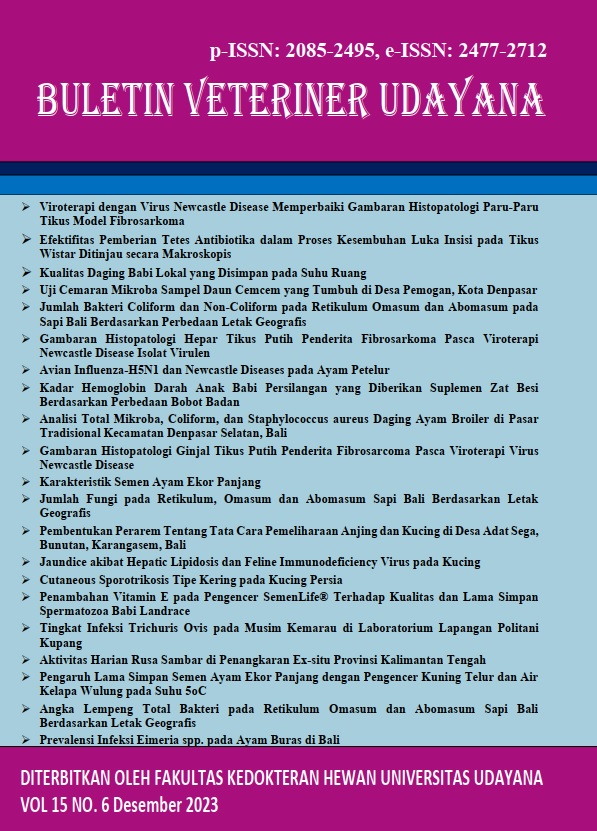NUMBER OF COLIFORM AND NON-COLIFORM BACTERIA IN RETICULUM OMASUM AND ABOMASUM IN BALI CATTLE BASED ON GEOGRAPHICAL DIFFERENCES
Abstract
Bali cattle are germplasm originating from the island of Bali which is the most popular in Indonesia, so it is highly conserved and maintained for its population. This study aims to determine the level of livestock health, determine the content of good feed for breeders to support the development and increase in the population of Bali cattle in Indonesia. This research was conducted by taking samples at the Slaughterhouse in the form of the stomach contents of Bali cattle consisting of reticulum, omasum, and abomasum. The samples taken were 32 Bali cattle, 16 of which came from the lowlands and highlands. The method used in this study was the cultivation of bacteria on EMBA media using the scatter method. Data on the number of colonies of Coliform and Non-coliform bacteria growing on EMBA media are tabulated in the form of mean ± standard deviation (SD). The data obtained were then analyzed using the Independent sample T-test to determine its significance value. Mean ± SD results of the analysis of the number of bacteria the number of lowland Coliform bacteria, namely reticulum, omasum, and abomasum, namely 54.31±17.469x103 CFU/g, 52.63±19.071x103 CFU/g, and 59.63±18,011x103 CFU/g. While from the highlands, namely: 64.88±14.908x103 CFU/g, 61.94±13.056x103 CFU/g, and 62.00±12.920x103 CFU/g. While non-coliform bacteria from the lowlands were: 50.19±21.182x103 CFU/g; 44.38±18.279x103 CFU/g, and 38.63±18.998x103 CFU/g. The highlands are: 47.63±10.620x103 CFU/g, 46.56±13.301x103 CFU/g, and 45.00±12.517x103 CFU/g. The results of the follow-up study of the Independent Simple T-test showed that the number of Coliform and Non-coliform bacteria from each organ had no significant effect (Sig > 0.05) in the highlands and lowlands. Based on the results of this study, it can be concluded that differences in geographical location have no significant effect on the number of Coliform and Non-coliform bacteria in Bali cattle reared in the lowlands and highlands.
Downloads
References
Bambang AG, Fatimawali, Kojong NS. 2014. Analisis Cemaran Bakteri Coliform dan Identifikasi Escherichia coli pada Air Isi Ulang dari Depot di Kota Manado. J. Ilm. Farm. 3(3): 325-334.
Besung INK. 2013. Analisis Faktor Tipe Lahan Dengan Kadar Mineral Serum Sapi Bali. Bul. Vet. Udayana. 5(2): 96-107.
Direktorat Jenderal Peternakan dan Kesehatan Hewan Kementerian Pertanian, 2021, Statistik Peternakan dan Kesehatan Hewan 2021, Jakarta: Direktorat Jenderal Peternakan dan Kesehatan Hewan Kementerian Pertanian RI.
Hungate RE. 1996. The Rumen and Its Microbes. Academic Press. NewYork and London.
Jan R, Sudrana IP, Kasip LM. 2015. Pengamatan Sifat-sifat yang Mempunyai Nilai Ekonomi Tinggi pada Sapi Bali di Kota Mataram. J. Ilmu Teknol. Peternakan Indon. 1(1): 53-59.
Kusriatmi, Oktaviani R, Syaukat Y, Said, A. 2014. Peranan Teknologi Inseminasi Buatan (IB) Pada Produksi Sapi Potong Di Indonesia. J. Argo. Ekonomi. 32(1).
Lynch JM, Poole N. 1979. Water pollution and its prevention.p 226-245. In Microbial Ecology: A Conceptual Approach. Blackwell scientific Publication. Oxford.
Pramita IDADP, Besung INK, Sampurna IP. 2016. Jumlah Non Coliform dan Total Bakteri Pada Sapi Bali di Dataran Tinggi dan Dataran Rendah di Bali Pasca Pemberian Mineral. Bul. Vet. Udayana. 8(1): 52-58
Partama IBG. 2013. Nutrisi dan Pakan Ternak Ruminansia. Denpasar: Udayana University Press.
Sari NF. 2017. Mengenal Keragaman Mikrobia Rumen Pada Perut Sapi Secara Molekuler. Biol. Trends. 8. 1
Suranjaya IG, Ardika IN, Indrawati RR. 2010. Faktor-Faktor yang Mempengaruhi Produktivitas Sapi Bali di Wilayah Binaan Proyek Pembibitan dan Pengembangan Sapi Bali di Bali. Maj. Ilm. Pet. 13(3): 83-87.
Suhartanto, Kustantinan dan Padmowijoto. 2000. Degradasi In Sacco Bahan Organik dan Protein Kasar Empat Macam Bahan Pakan diukur Menggunakan Kantong Inra dan Rowet Research Institute. Bul. Pet. 24(2): 82-93.
Suwiti NK, Sentena P, Watiningsih N, Puja K. 2012. Peningkatan Produksi Sapi Bali Unggul Melalui Pengembangan Model Peternakan Terintegrasi. Laporan Penelitian Tahap I Penprinas MP3EI 2011-2025.
Wiliantara PP, Besung IN, Tono K, 2018. Bakteri Coliform dan Non-Coliform yang Diisolasi dari Saluran Pernapasan Sapi Bali. Bul. Vet. Udayana. 10(1): 40-44.
Xue D, Chen H, Luo X, He Y, Zhao X. 2018. Microbial Diversity In The Rumen, Reticulum, Omasum, And Abomasum Of Yak On A Rapid Fattening Regime In An Agro-Pastoral Transition Zone. J. Microbiol. 56(10): 733-743.





